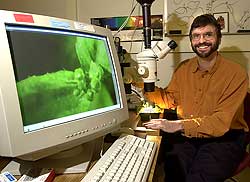|
West Lafayette, Indiana
February 19, 2002
Using a compact green plant,
Purdue University researchers are unraveling mysteries about how
genes affect plant growth and learning possible ways to control
growth that eventually could lead to higher crop yields.
|
The Purdue scientists cloned a
gene in the plant Arabidopsis (ah-rah-baa-dop-sis) required
for controlling development and shape of cells and tissue,
said Daniel Szymanski, assistant professor of agronomy. The
study detailing how a mutant form of the gene SPIKE1 affects
plant development is published in the latest issue of The
Plant Cell. "Ultimately
things like organ shape and whole plant architecture are
really important for crop yield in the field," said
Szymanski, a molecular biologist. "The angle of the leaves
defines how tightly you can pack plants in when you plant
them. Root architecture controls the ability of plants to
take up nutrients." |
 |
|
Daniel
Szymanski, Purdue University plant cell biologist, looks at
the small plant Arabidopsis that is helping him answer big
questions about what controls the shape, structure and
function of cells. (Purdue News Service - Photo by Tom
Campbell) |
Szymanski and his research team
cloned SPIKE1, and then they compared a mutant plant with a
normal Arabidopsis. The shape and size of the leaves and roots
were stunted in the plant with the mutated gene, spike1. This
gave the scientists clues as to the gene's function in altering
the plant's architecture.
"The phenotype of this mutant
plant suggests that reorganization of the cytoskeleton is
affected in the mutant," Szymanski said. "That is evidence that
this gene is involved in controlling cell shape and organization
of the tissue."
The cytoskeleton is the internal
structure of the cell and determines the cell's shape. The
shapes and sizes of cells determine the architecture of
leaves and roots. Szymanski said that SPIKE1 is similar to a
family of genes found in humans, worms and fruit flies that
also regulate how signals are transmitted from the outside
of the cell to the cytoskeleton to control cell shape and
organization of the tissue.
This research is an early step in discovering important
answers about plant development, Szymanski said.
"Ultimately we'd like to change the activity either of this
gene or other genes in the cytoskeleton control pathway in
order to regulate growth and development," he said. "This
could be achieved either through genetic engineering or
breeding and selection". |
 |
|
The plant on the left is a
normal one-week-old Arabidopsis seedling. On the right is an
Arabidopsis of the same age but containing a mutant gene
that has caused smaller misshapen leaves. (Photo from
research lab of Daniel Szymanski) |
Because the mutant spike1 is
lethal to seedlings, using it to develop desirable plants
wouldn't be possible, he said.
"We'd like to identify other components of the pathway in which
this normal gene, SPIKE1, is involved, or modify the activity of
this gene to increase lateral roots or the total amount of root
surface area without having all these other adverse effects on
growth," Szymanski said.
Little is known at this time about plant cell biology, he said,
so the current long-term goal is to learn more about how genes
affect the cell growth.
"If we want to genetically engineer cells to have different
physical properties or different chemical composition, we need
to learn a lot more about the basics of plant cell biology,"
Szymanski said.
Arabidopsis, often used by plant biologists as a research tool,
is the perfect model plant for several reasons, he said. It has
the same physiology as most crop species so information garnered
from its study is transferable; research seedlings are small ‹
1-2 centimeters in diameter, so many can be
grown in a small space; the lifecycle of the plant is short; and
different examples of the plant are easily obtained.
"I can learn things in a year or two that would take me eight or
10 years to learn in another plant species," Szymanski said.
The U.S. Department of Agriculture and the National Science
Foundation provided funding for this research.
Writer: Susan A. Steeves, 765-496-7481, ssteeves@aes.purdue.edu
Source: Daniel Szymanski, 765-494-8092, dszyman@purdue.edu
Related Web sites:
Plant Cell:
http://www.plantcell.org
Purdue Motility Group:
http://www.bio.purdue.edu/Bioweb/Cytoskeletal/index.html
Purdue plant biology program:
http://www.biochem.purdue.edu/~plantbiology/
ABSTRACT
The Arabidopsis SPIKE1 Gene is Required for Normal Cell Shape
Control and Tissue Development
Jin-Long Qiu, Ross Jilk, M. David Marks, and Daniel B. Szymanski
Regulated growth and cell shape control are fundamentally
important to the function of plant cells, tissues, and organs.
The signal transduction cascades that control localized growth
and cell shape, however, are not known. To better understand the
relationship between cytoskeletal organization, organelle
positioning, and regulated vesicle transport, we conducted a
forward genetic screen to identify genes that regulate
cytoskeletal organization in plants. Because of the distinct
requirements
for microtubules and actin filaments during leaf trichome
development, a trichome-based morphology screen is an efficient
approach to identify genes that affect cytoplasmic organization.
The seedling lethal spike1 mutant was identified based on
trichome, cotyledon, and leaf-shape defects. The predicted
SPIKE1 protein shares amino acid identity with a large family of
adapter proteins present in humans, flies, and worms that
integrate extracellular signals with cytoskeletal
reorganization. Both the trichome phenotype and
immunolocalization data suggest that SPIKE1 also is involved in
cytoskeletal reorganization. The assembly of laterally clustered
foci of microtubules and polarized growth are early events in
cotyledon development, and both processes are misregulated in
spike1 epidermal cells.
---------------------------------------------------------------------
Jeanne Norberg, Director, Purdue News Service
(765) 494-2084; jnorberg@purdue.edu
Pager: 423-8662; Home: 449-4986
Fax: (765) 494-0401
http://news.uns.purdue.edu
--
Beth Forbes, Ag News Coordinator
Ag Communications Service
(765) 494-2722
bforbes@aes.purdue.edu
Fax: (765) 496-1117
http://persephone.agcom.purdue.edu/AgCom/news/
|